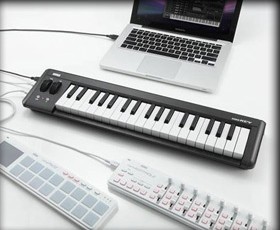Recent advancements in technology have moved the boundaries of what can now be achieved in your own recording studio at home.
Over the last few years, the rules have changed and they continue to do so mainly thanks to more features being added to home recording software. The old requirements of needing expensive recorders and a room full of gear and cables is not a necessity now and the once large home studios can now fit into a much smaller space with less equipment. Computers have allowed this change and offer almost anyone with a desire to record music a cost effective solution to do so.
A budding artist no longer needs separate multi-track machines, recorders, mixing equipment and tons of outboard gear. The humble PC can handle most of these jobs and handles hundreds of functions that used to be the job of multiple hardware units. Computer software can now even replace the need for many musical instruments if you wish as they simulate guitars, drums and keyboards with ease.
Home music software now includes advanced features such as sequencers and digital mixers all built in, not only that but the quality of sound reproduction is high from most specialist home recording software. Don’t think along the lines of the old 4 track cassette studios here, the sound reproduction rivals fully fledged and proper recording studios.
This is great news for solo artists and bands alike that are on tight budgets and are looking to progress with their love of music and want to produce their own album. For a relatively low budget and equipment consisting of PC software, microphones, audio interfaces and pre-amps the job can be completed. This software is available for Windows based PC’s and Apple Mac’s.
Your home recording studio is your instrument to create your album and of course the more practice you have with it the better the output will become. If you are serious about creating the perfect album, you must be serious about learning the techniques needed to use your home studio and this will mean designating time and effort to hone your skills.
A major recording studio will consist of vocal processors, limiters, equalization, multi-track recorders, delays, computer automation and reverb consoles that put the input together to create your music. A modern computer software package will include all of these components too, so acquiring the right knowledge to get the sound in your head down onto a CD or mp3 file is paramount.
Good software means that all music from every instrument can be funnelled from a live state into the computer where tweaking and perfecting the sound can occur. It simply acts as a very convenient and powerful tool which has enabled many solo artists and bands with little budgets to realise their dreams of producing their own albums. This way the cost of renting a professional recording studio has been eradicated however the quality of the output can be the same.
While there can be a steep learning curve to mastering your home studio equipment, the process can be very enjoyable. Don’t get too bogged down with unnecessary technical details early on and just have fun with it.
Where Do I Start?
Nowadays there are so many bespoke music software solutions available that it can be hard to fathom out which is best, or at least which is the best for your own needs. With that in mind below we take a look at some of the options to help you make a choice.
- Logic Studio (Apple MAC) – Designed specifically for Apple MAC computers, Logic Studio is one of the most favoured software packages available for these PC’s. They enable easy writing, recording, editing, mixing and high performance live tools with many effect plug-ins and samplers. This is a good all-round package that has many features and options priced around $500.
- Digidesign – This self-proclaimed leader in digital music software has a very strong community following and is a popular solution among many artists and bands. The range of options includes ‘ProTools’ which is a fully-fledged professional music station incorporating all features that would be found in a traditional music studio. Advanced features and excellent quality make this a good option for he serious music producer and is priced at about $400.
- Ableton Live – This is for both Windows and MAC operating systems and aims to cover the user with the complete musical production process from inspiration to finished product. There are 3 variations including the standard suite, Ableton Live and intro package. Prices range from $450 to $850.
Other software that may be of interest and are designed for various styles of music includes the following:
- Soundjunction – http://www.soundjunction.org/default.aspa
- Band In A Box – http://www.band-in-a-box.com/
- Fruity Loops – http://flstudio.image-line.com/
- Sound Forge – http://www.sonycreativesoftware.com/soundforgesoftware
- Acid Music Studio – http://www.sonycreativesoftware.com/musicstudio
When choosing music software for your computer, you should not only analyse the price but also the support and add-ons that may be available. For example plug-ins can add to the functionality of your software enhancing your options and creativity with your music production. Look for downloads and plug-ins for new presets, clips, samples as well as new features and product updates.
Many of these products will allow either a free trial of the software or a cheap ‘tester’ sample of what can be achieved with it before purchase. This is handy if you are stuck making a choice from the wide range available.
In Part 2 of this article we will look at how you can go about starting to create your music with music software programs.






